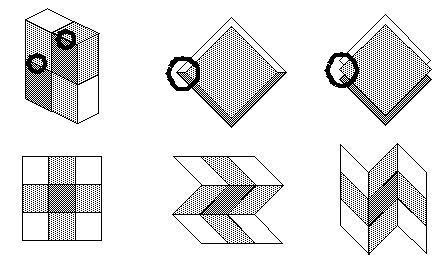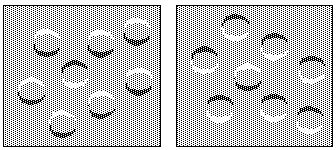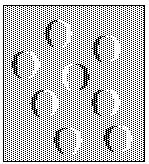Plato's Cave: Light Phenomena
Phenomena of Lightness, Brightness & Illuminance
The perception of form is intimately tied in with the perception of
both "lightness" (= surface reflectance) as well as the perceived
direction of illumination. Adelson presents a number of interesting
examples of this interaction. In the first one (top left) the two
circled edges are locally identical, although one is
perceived as a form edge with no change in reflectance, while the
other appears as a reflectance edge with no form edge.
In the next illusion (top center & top right) these two figures are
identical except for a small difference at the circled corner. This
local difference however propagates throughout the entire figure,
generating a completely different percept of depth.
The last example (bottom row) shows how three figures which are
topologically identical generate completely different spatial
percepts, with form edges and illuminance edges interchanging in
response to subtle differences in the global configuration.

The next figure (left) shows how a repeated pattern of light and dark
produces simultaneously a percept of an overhead light source, and a
three-dimensional percept of bumps and dimples. When the picture is
inverted (right) the bumps become dimples, and the dimple becomes a
bump, showing that the light source is preferentially perceived to be
above, the usual location for light sources.
 When the picture is rotated by 90 degrees, the percept becomes
ambiguous, with the illuminant perceived either to the right or the
left, creating bumps or dimples accordingly. Notice that the
perception of the shapes and the illuminant are always synchronized,
i.e. when one switches, then the other switches, in order to maintain
a globally consistent percept.
When the picture is rotated by 90 degrees, the percept becomes
ambiguous, with the illuminant perceived either to the right or the
left, creating bumps or dimples accordingly. Notice that the
perception of the shapes and the illuminant are always synchronized,
i.e. when one switches, then the other switches, in order to maintain
a globally consistent percept.
 What kind of model can explain these phenomena?
What kind of model can explain these phenomena?
Return to argument
Return to Steve Lehar



